Christopher Hector looks at the long standing debate – are we breeding for that elegant modern type, or the strength to handle the most difficult dressage movements? Or is a synthesis just around the corner?
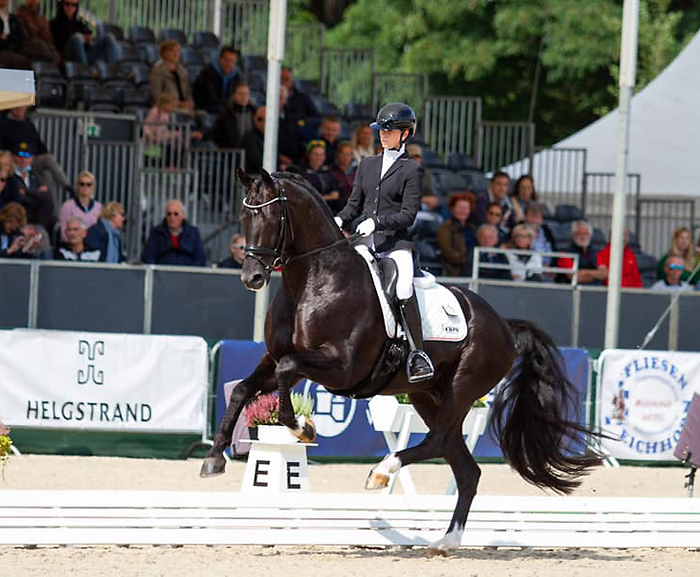
Kjento (Verden Turnier image)
Looking at Kjento, the winner of the 6-y-o Championship at Verden, I was reminded of the comments in a previous interview of Gertjan Van Olst who owns both the young stallion, and his sire, Negro.
We say Valegro – who is also by Negro – was not such a modern type, Totilas is not such a modern type, but they were great Grand Prix horses, are we breeding for the wrong type if we want Grand Prix performance?
“I don’t think so, but that is a discussion that has been going on for a long time. The Grand Prix horses you mentioned – like the De Niro sons – are not the nice modern types. There was a time when the two types were far apart, but these two worlds are coming closer. People on the stallion commission like the late Wim Ernes who knew the sport, and he knew what is going on, they bring those two worlds together, the big sport and the breeding thing, is coming more and more together. They know what is asked in the Grand Prix ring and they try to bring that in at the stallion selection.”
So we should look more for the old-fashioned type?
“Especially for the hind legs, we should look to the connections, the good connection to the back, and the temperament of course is more and more important. For a certain while we have been too much over-the-top, focusing on long legs and uphill and all those things, and now we are seeing what you really need in the ring, and it is coming closer together.”
Kjento was not bred by Gertjan Van Olst, he was bred by the Van Os family, who are well-known Dutch breeders, indeed in 2012 they were proclaimed KWPN Breeders of the Year. The black stallion descends from the Van Os foundation mare, Diana, who was by Doruto, the Trakehner imported to Holland in 1964.
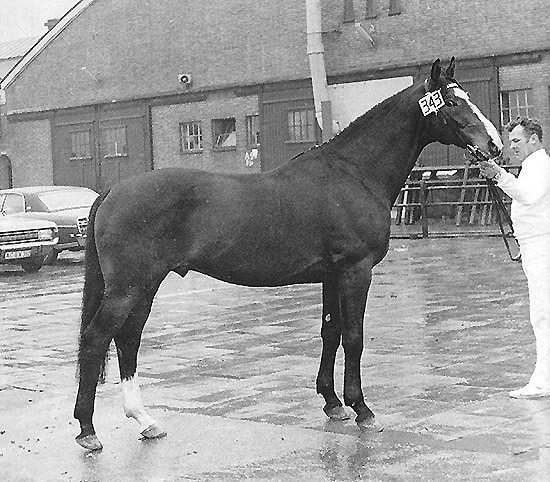
Doruto
In spite of covering very small books of mares, Doruto emerged as perhaps the first dressage sire specialist (in the world?) and produced more than 20 progeny that competed at Intermediaire level – including German team Gold Medallist at the 1986 World Championship, Jo Hinneman’s Ideaal (the breeding of the horses in the German team at those championships was a huge embarrassment to the German breeding authorities – all four German riders were sitting on Dutch horses), Jo Rutten’s Banjo, 9th at the 1972 Olympics, and Robby, ridden into 10th place at those same 1986 World Champs by Jo’s son Bert…
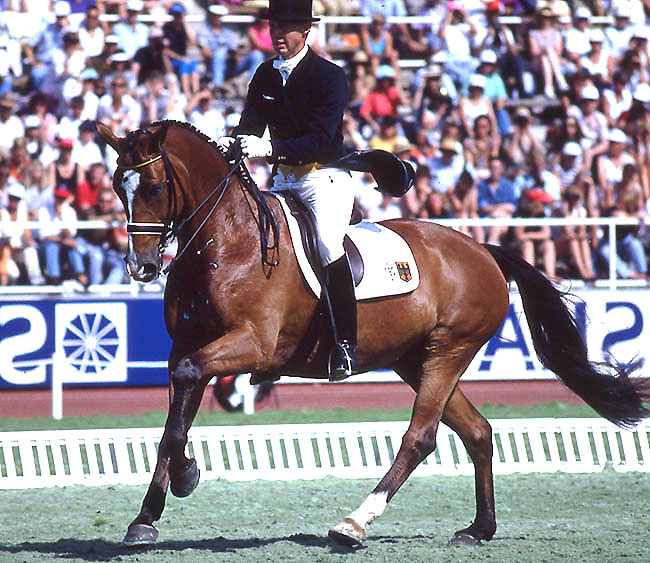
Ideaal – ridden later in his career by Sven Rothenberger
Obviously the Van Os family were in the vanguard breeding horses specifically for dressage. They bred Diana to the German dressage star, Rubinstein, to produce Koriana in 1992. Bred to the Small Tour dressage competitor, Juventus (by the Ulft son, Dublin – Juventus also carries a cross of Doruto on his mare line) Koriana produced Poriana, who bred to Jazz produced Kjento’s dam, Zoriana – all three mares competed at Medium level dressage.
The Dutch breeders, and their breeding authority, were moving in the direction of specialised – dressage or jumping – breeding by the early 90’s – at a time when the German breed societies were still officially aiming at the ‘all round’ horse.
Just how far this process has gone was apparent at the 2020 KWPN stallion show where the young colts were being evaluated by real dressage experts. Their selection commission was headed up by international dressage competitor and international coach, Bert Rutten, joined by one of the real master dressage trainers, Johan Hamminga, a wizard with young horses and Grand Prix competitors. The third member of the group, Marian Dorresteijn, may not have been as famous as dressage competitor as her sister, Coby van Baalen, but she too competed at the highest level. I can think of no other stallion commission that looked through such hands on, experienced and knowledgeable eyes…
One very interested observer at that licensing was Jens Meyer a born-and-bred a Hanoverian breeder. His father before him was a breeder of licensed stallions, and Jens, as a young man, learnt his craft at the State Stud Celle, before setting up one of Germany’s powerhouse stallion stations – Hengststation Jens Meyer. There he stood, amongst others, His Highness, Falsterbo, Dacaprio, Cashman and Herzensdieb.
Nowadays, Jens has cut back on the stallion involvement, although his wife is the part owner of Damsey, another horse that Jens discovered. Jens Meyer has a busy career judging all over the world, and acting as an advisor to the Blue Hors Stud. When I talked to Jens at the KWPN show, I was just a little surprised to find that this died-in-the-wool Hanoverian breeder, was now a big fan of the Dutch horse.
“I like it that they have the philosophy to produce dressage horses and not just foals. When you listen to Bert Rutten really carefully, he’s a horse breeder, he rode Grand Prix, and when he talks about the horses, there is an idea you can follow. When he talks about the walk, he is not just talking about over track, he is talking about the right rhythm, and if horses have this, they are going to be able to do piaffe. He has these ideas, and he gives them to the breeders – so they are not just looking for medium trot.”
At the press conference I asked Mr Rutten if he detected any weaknesses in the 2020 crop?

“In the horses we graded, I don’t think we have seen a lot of weaknesses. What we have seen is that in general we have uphill horses, a lot of uphill horses with a strong hind leg and a nice uphill shoulder, and good moving horses. We are speaking of a strong year this year.”
There is still a little tendency for the hind legs to be out behind in the trot…
“Sometimes, there is still the odd tendency where they go too far out behind, then we don’t invite them to Ermelo for the performance test. But if they are just a little out, and they have a lot of scope, and they really come off the floor and they have self carriage, then we still invite them to Ermelo for the stallion testing – Ermelo is the test, how good are they, and then we will see, can they come under themselves, yes or no. The ones we took that were a little out behind, when they come in hand in the presentation, when they trot them in hand and hold them back a little bit, then if they come under, then that’s the indication that we look for, if the pedigree and everything else is interesting.”
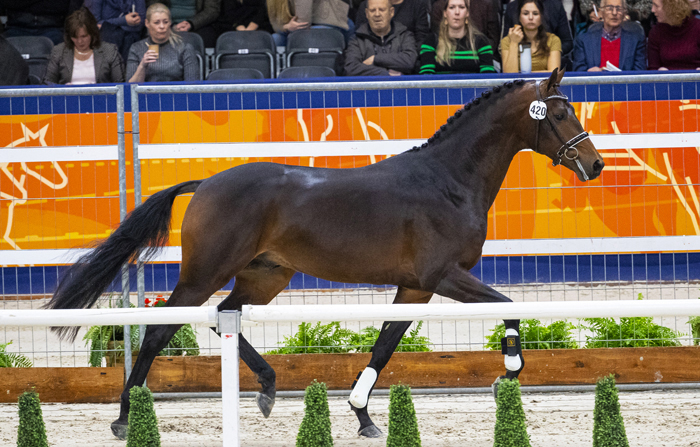
The Dutch / German cross: Magic Boy at the 2020 licensing, was bred in Holland but is two thirds German, by Fürstenball out of a Damsey / Flemmingh mare. He was selected for the performance test. (photo – Digishots)
We saw over and over the cross Dutch / German, German / Dutch, what do you think you are getting from the German bloodlines?
“The blood affinity (Mr Rutten is talking about the concentration of the same bloodlines, line breeding or in breeding) goes down, that’s in the first place, the Germans, they also have good dressage horses so I think the cross breeding between KWPN and German horses is very important, also to keep the blood affinity down in the dressage community.”
At the press conference after the jumping horses licensing, the chairman said, oh we are not like the Belgians we don’t have a problem with in-breeding, but looking at the first five horses that made it to your presentation, the first had two crosses of Ferro, two crosses of Jazz, the next had two Jazz, then Ferro two, Jazz two, Krack C two, Ferro three, is this a welcome consolidation of bloodlines, or a potential problem – too much blood affinity?
“We are aware of that and we try to bring it down as much as we can, but it just shows that these bloodlines are bringing the best horses. When they have those stallions in their pedigree, we are not going to say, we don’t want you because you have Ferro, or you have Jazz… we select the best horses.”
It’s that important, the performance test?
“The most important, it’s the only thing that is important. We breed for top sport, that’s our goal, and you have to select as close as possible to your goal.”
Looking at Kjento’s pedigree there is not a great deal of ‘blood affinity’ – helped by the infusion of Rubinstein.
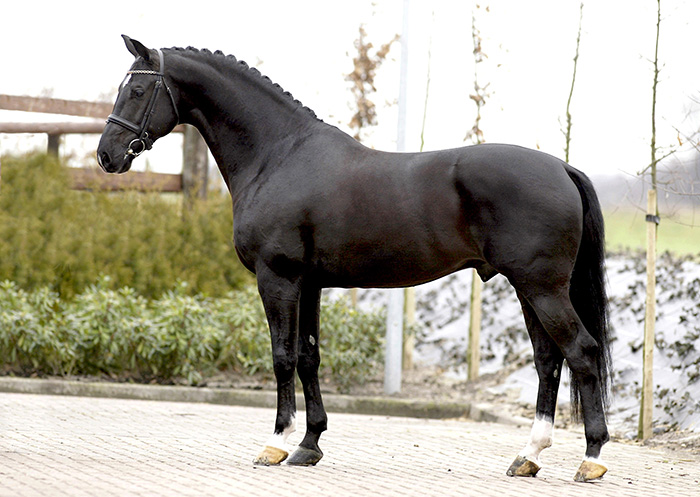
Negro
Kjento’s sire, Negro, rocketed on to the WBFSH dressage sires’ rankings, on the basis of his son, dressage superstar, Valegro and Valegro’s success attracted lots and lots of mares. Negro ranked ninth on the 2015 WBFSH top ten, up from 18th the previous year – but without the points earned by Charlotte Dujardin’s gelding, the fall from grace was swift – by 2020, Negro does not make the WBFSH top 100, and believe me there are some seriously dud stallions in that list of 100.
Does Kjento represent the next step in Dutch breeding, Grand Prix competitor, sire of Grand Prix competitors, type and strength? Time will answer both questions…
